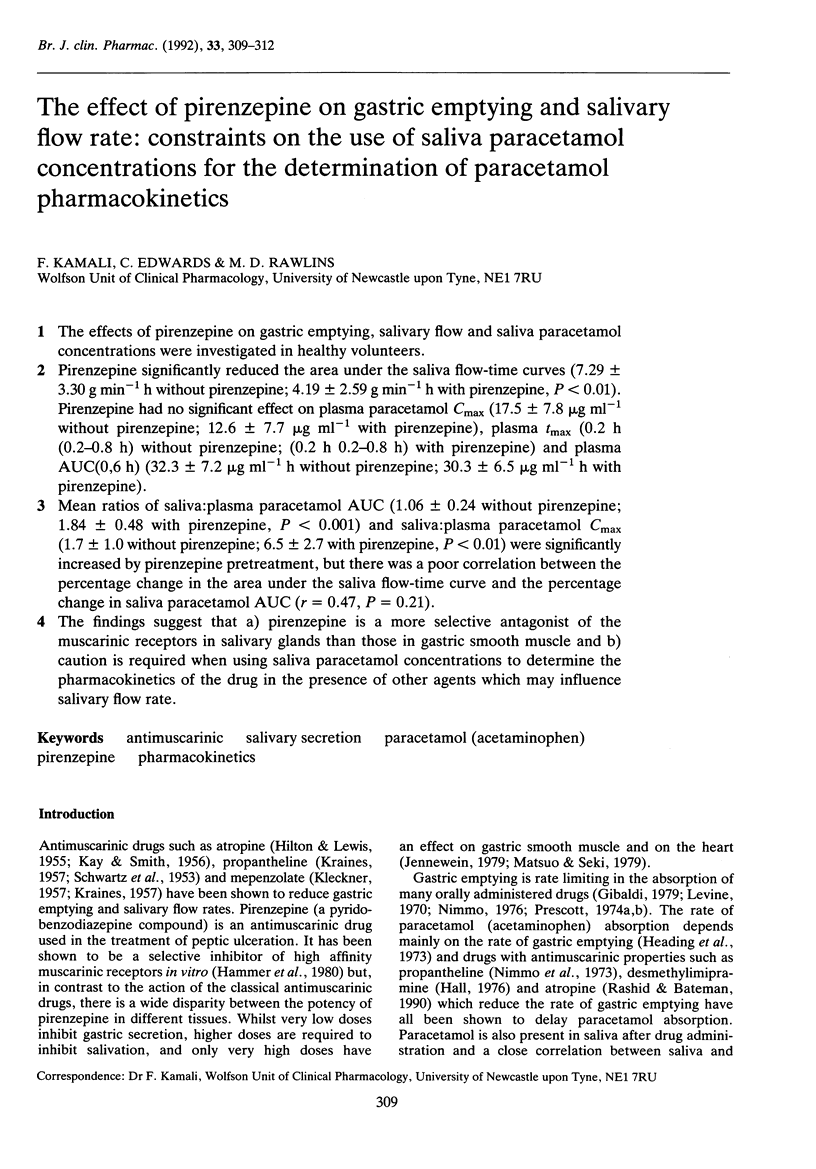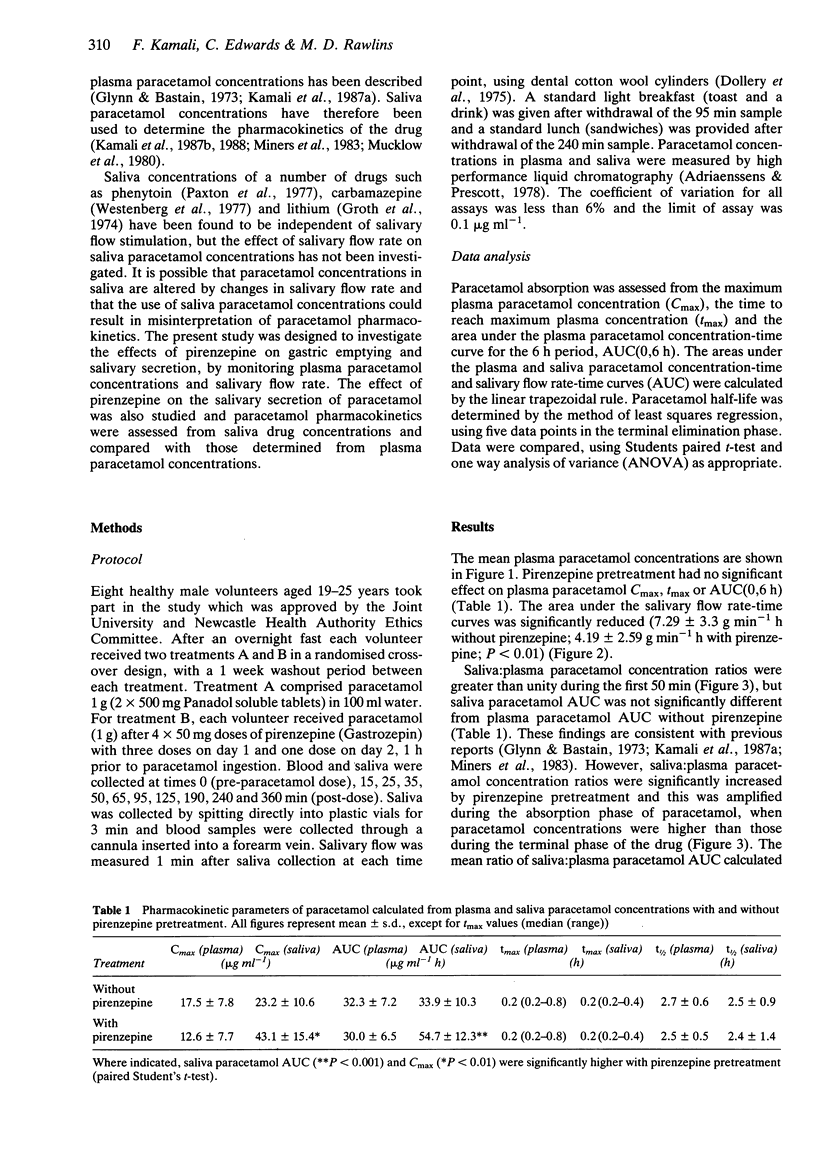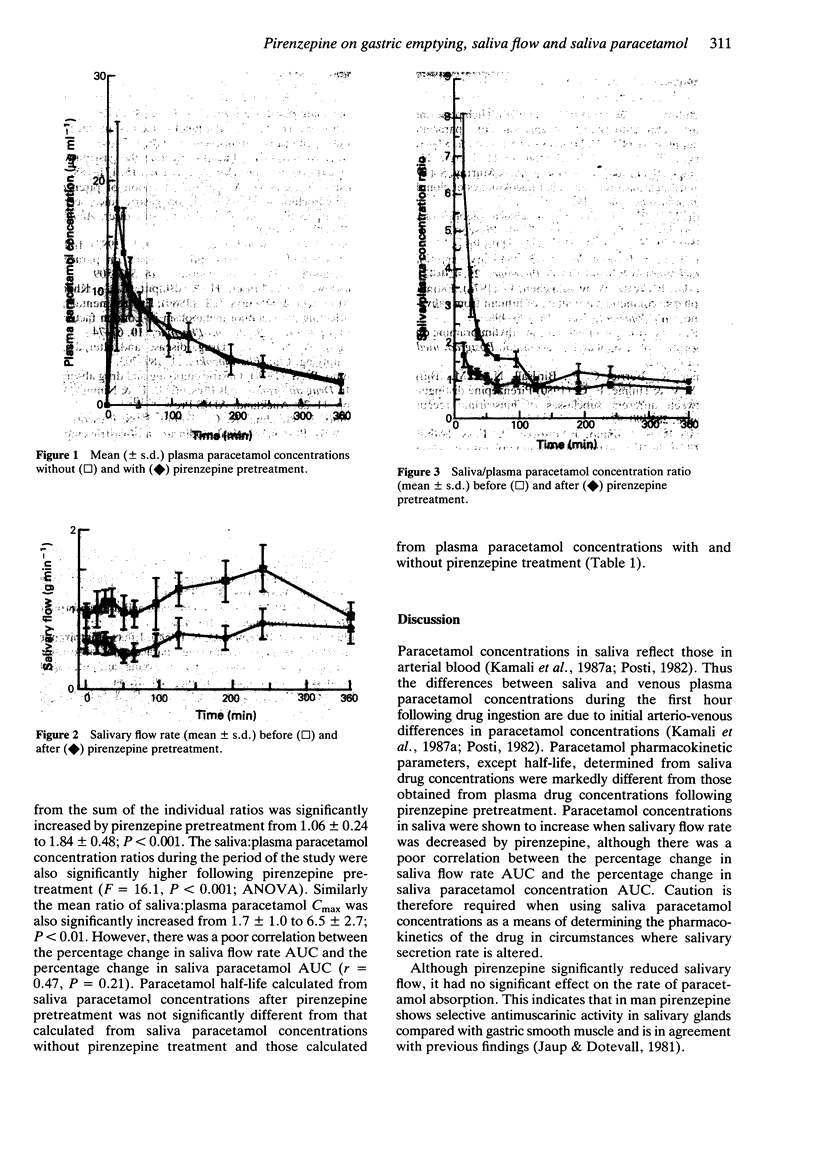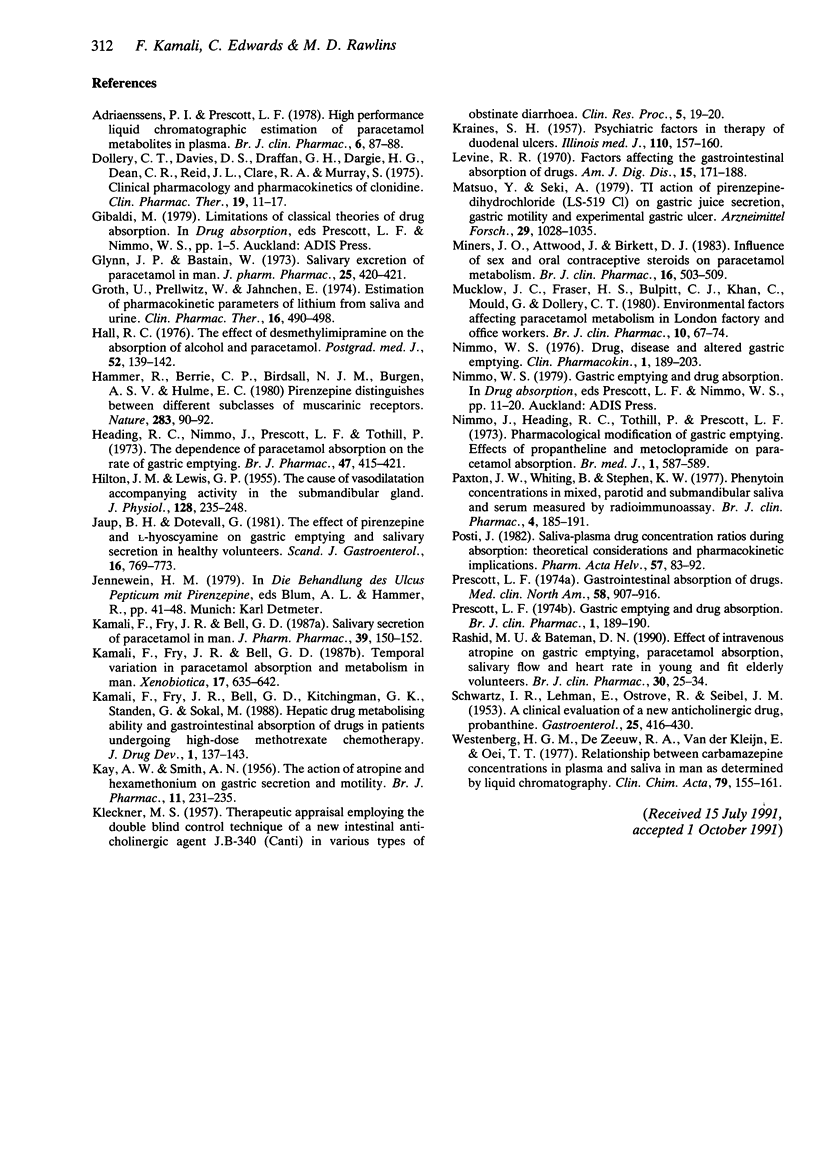Abstract
1. The effects of pirenzepine on gastric emptying, salivary flow and saliva paracetamol concentrations were investigated in healthy volunteers. 2. Pirenzepine significantly reduced the area under the saliva flow-time curves (7.29 +/- 3.30 g min-1 h without pirenzepine; 4.19 +/- 2.59 g min-1 h with pirenzepine, P less than 0.01). Pirenzepine had no significant effect on plasma paracetamol Cmax (17.5 +/- 7.8 micrograms ml-1 without pirenzepine; 12.6 +/- 7.7 micrograms ml-1 with pirenzepine), plasma tmax (0.2 h (0.2-0.8 h) without pirenzepine; (0.2 h 0.2-0.8 h) with pirenzepine) and plasma AUC(0.6 h) (32.3 +/- 7.2 micrograms ml-1 h without pirenzepine; 30.3 +/- 6.5 micrograms ml-1 h with pirenzepine). 3. Mean ratios of saliva:plasma paracetamol AUC (1.06 +/- 0.24 without pirenzepine; 1.84 +/- 0.48 with pirenzepine, P less than 0.001) and saliva:plasma paracetamol Cmax (1.7 +/- 1.0 without pirenzepine; 6.5 +/- 2.7 with pirenzepine, P less than 0.01) were significantly increased by pirenzepine pretreatment, but there was a poor correlation between the percentage change in the area under the saliva flow-time curve and the percentage change in saliva paracetamol AUC (r = 0.47, P = 0.21). 4. The findings suggest that a) pirenzepine is a more selective antagonist of the muscarinic receptors in salivary glands than those in gastric smooth muscle and b) caution is required when using saliva paracetamol concentrations to determine the pharmacokinetics of the drug in the presence of other agents which may influence salivary flow rate.
Full text
PDF



Selected References
These references are in PubMed. This may not be the complete list of references from this article.
- Adriaenssens P. I., Prescott L. F. High performance liquid chromatographic estimation of paracetamol metabolites in plasma. Br J Clin Pharmacol. 1978 Jul;6(1):87–88. doi: 10.1111/j.1365-2125.1978.tb01687.x. [DOI] [PMC free article] [PubMed] [Google Scholar]
- Dollery C. T., Davies D. S., Draffan G. H., Dargie H. J., Dean C. R., Reid J. L., Clare R. A., Murray S. Clinical pharmacology and pharmacokinetics of clonidine. Clin Pharmacol Ther. 1976 Jan;19(1):11–17. doi: 10.1002/cpt197619111. [DOI] [PubMed] [Google Scholar]
- Glynn J. P., Bastain W. Salivary excretion of paracetamol in man. J Pharm Pharmacol. 1973 May;25(5):420–421. doi: 10.1111/j.2042-7158.1973.tb10042.x. [DOI] [PubMed] [Google Scholar]
- Groth U., Prellwitz W., Jähnchen E. Estimation of pharmacokinetic parameters of lithium from saliva and urine. Clin Pharmacol Ther. 1974 Sep;16(3):490–498. doi: 10.1002/cpt1974163part1490. [DOI] [PubMed] [Google Scholar]
- HILTON S. M., LEWIS G. P. The cause of the vasodilatation accompanying activity in the submandibular salivary gland. J Physiol. 1955 May 27;128(2):235–248. doi: 10.1113/jphysiol.1955.sp005302. [DOI] [PMC free article] [PubMed] [Google Scholar]
- Hall R. C., Brown D., Carter R., Kendall M. J. The effect of desmethylimipramine on the absorption of alcohol and paracetamol. Postgrad Med J. 1976 Mar;52(605):139–142. doi: 10.1136/pgmj.52.605.139. [DOI] [PMC free article] [PubMed] [Google Scholar]
- Hammer R., Berrie C. P., Birdsall N. J., Burgen A. S., Hulme E. C. Pirenzepine distinguishes between different subclasses of muscarinic receptors. Nature. 1980 Jan 3;283(5742):90–92. doi: 10.1038/283090a0. [DOI] [PubMed] [Google Scholar]
- Heading R. C., Nimmo J., Prescott L. F., Tothill P. The dependence of paracetamol absorption on the rate of gastric emptying. Br J Pharmacol. 1973 Feb;47(2):415–421. doi: 10.1111/j.1476-5381.1973.tb08339.x. [DOI] [PMC free article] [PubMed] [Google Scholar]
- Jaup B. H., Dotevall G. The effect of pirenzepine and L-hyoscyamine on gastric emptying and salivary secretion in healthy volunteers. Scand J Gastroenterol. 1981;16(6):769–773. doi: 10.3109/00365528109181002. [DOI] [PubMed] [Google Scholar]
- KAY A. W., SMITH A. N. The action of atropine and hexamethonium in combination on gastric scretion and motility. Br J Pharmacol Chemother. 1956 Sep;11(3):231–235. doi: 10.1111/j.1476-5381.1956.tb01059.x. [DOI] [PMC free article] [PubMed] [Google Scholar]
- KRAINES S. H. Psychiatric factors in therapy of duodenal ulcer. Ill Med J. 1956 Oct;110(4):157–164. [PubMed] [Google Scholar]
- Kamali F., Fry J. R., Bell G. D. Salivary secretion of paracetamol in man. J Pharm Pharmacol. 1987 Feb;39(2):150–152. doi: 10.1111/j.2042-7158.1987.tb06967.x. [DOI] [PubMed] [Google Scholar]
- Kamali F., Fry J. R., Bell G. D. Temporal variations in paracetamol absorption and metabolism in man. Xenobiotica. 1987 May;17(5):635–641. doi: 10.3109/00498258709043970. [DOI] [PubMed] [Google Scholar]
- Levine R. R. Factors affecting gastrointestinal absorption of drugs. Am J Dig Dis. 1970 Feb;15(2):171–188. doi: 10.1007/BF02235648. [DOI] [PubMed] [Google Scholar]
- Matsuo Y., Seki A. Actions of pirenzepine-dihydrochloride (LS-519 Cl) on gastric juice secretion, gastric motility and experimental gastric ulcer. Arzneimittelforschung. 1979;29(7):1028–1035. [PubMed] [Google Scholar]
- Miners J. O., Attwood J., Birkett D. J. Influence of sex and oral contraceptive steroids on paracetamol metabolism. Br J Clin Pharmacol. 1983 Nov;16(5):503–509. doi: 10.1111/j.1365-2125.1983.tb02207.x. [DOI] [PMC free article] [PubMed] [Google Scholar]
- Mucklow J. C., Fraser H. S., Bulpitt C. J., Kahn C., Mould G., Dollery C. T. Environmental factors affecting paracetamol metabolism in London factory and office workers. Br J Clin Pharmacol. 1980 Jul;10(1):67–74. doi: 10.1111/j.1365-2125.1980.tb00503.x. [DOI] [PMC free article] [PubMed] [Google Scholar]
- Nimmo J., Heading R. C., Tothill P., Prescott L. F. Pharmacological modification of gastric emptying: effects of propantheline and metoclopromide on paracetamol absorption. Br Med J. 1973 Mar 10;1(5853):587–589. doi: 10.1136/bmj.1.5853.587. [DOI] [PMC free article] [PubMed] [Google Scholar]
- Nimmo W. S. Drugs, diseases and altered gastric emptying. Clin Pharmacokinet. 1976;1(3):189–203. doi: 10.2165/00003088-197601030-00002. [DOI] [PubMed] [Google Scholar]
- Paxton J. W., Whiting B., Stephen K. W. Phenytoin concentrations in mixed, parotid and submandibular saliva and serum measured by radioimmunoassay. Br J Clin Pharmacol. 1977 Apr;4(2):185–191. doi: 10.1111/j.1365-2125.1977.tb00692.x. [DOI] [PMC free article] [PubMed] [Google Scholar]
- Posti J. Saliva-plasma drug concentration ratios during absorption: theoretical considerations and pharmacokinetic implications. Pharm Acta Helv. 1982;57(3):83–92. [PubMed] [Google Scholar]
- Prescott L. F. Gastrointestinal absorption of drugs. Med Clin North Am. 1974 Sep;58(5):907–916. doi: 10.1016/s0025-7125(16)32088-0. [DOI] [PubMed] [Google Scholar]
- Rashid M. U., Bateman D. N. Effect of intravenous atropine on gastric emptying, paracetamol absorption, salivary flow and heart rate in young and fit elderly volunteers. Br J Clin Pharmacol. 1990 Jul;30(1):25–34. doi: 10.1111/j.1365-2125.1990.tb03739.x. [DOI] [PMC free article] [PubMed] [Google Scholar]
- SCHWARTZ I. R., LEHMAN E., OSTROVE R., SEIBEL J. M. A clinical evaluation of a new anticholinergic drug, pro-banthine. Gastroenterology. 1953 Nov;25(3):416–430. [PubMed] [Google Scholar]
- Westenberg H. G., de Zeeuw R. A., van de Kleijn E., Oei T. T. Relationship between carbamazepine concentrations in plasma and saliva in man as determined by liquid chromatography. Clin Chim Acta. 1977 Aug 15;79(1):155–161. doi: 10.1016/0009-8981(77)90473-9. [DOI] [PubMed] [Google Scholar]


